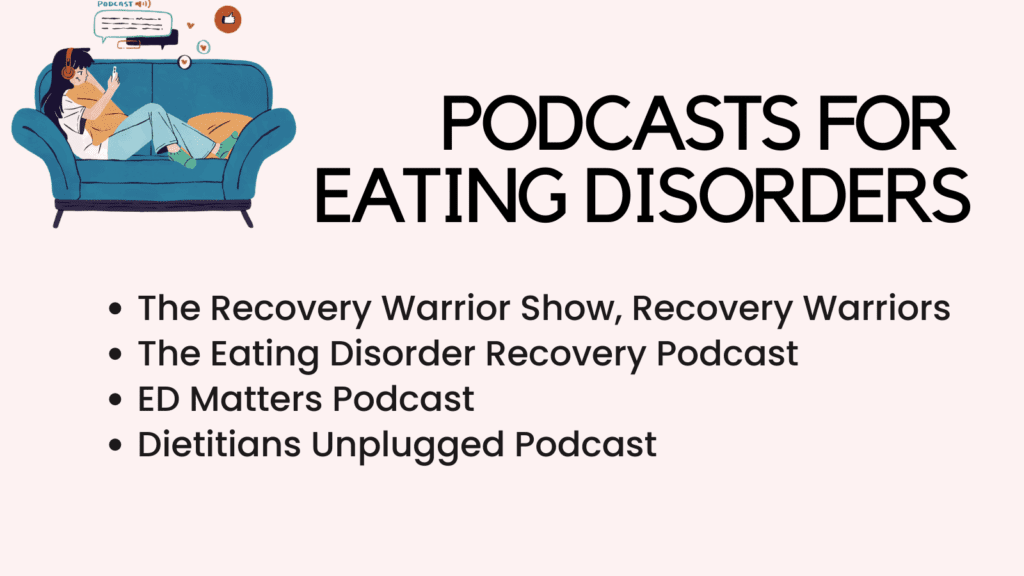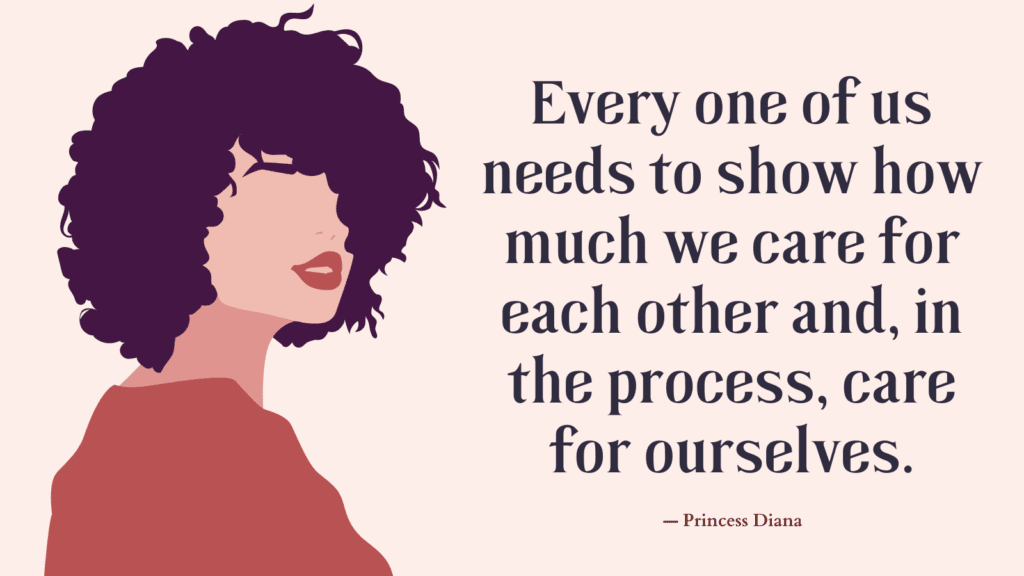Today you’re going to find out what triggers eating disorder relapse.
Disclosure: Some of the links below are affiliate links. This means that, at zero cost to you, I will earn an affiliate commission if you click through the link and finalize a purchase.
Top 3 Eating Disorder Relapse Triggers
Just as with recovery from alcohol and drug addictions, recovery from an eating disorder can include relapse.
The following is a list of common triggers for eating disorder relapse:
1. Self-Comparison
People recovering from eating disorders may compare themselves to glamorized and photoshopped people in media and may believe that they need to look a certain way or wear a certain dress size to be considered beautiful.
Instead, remind yourself that every body is unique and beautiful in its own way. If social media apps are creating so much pressure for you, consider deleting them to reset your perspective.
Related: How To Become More Body Positive? Best 12 Practices to Build Positive Body Image
2. Low Self-Esteem
When you feel bad about yourself and the way you look, it’s natural for you to use your eating disorder to numb your emotions and feel better.
However, disordered eating behaviors will only make you feel worse.
Instead, focus on healthier activities to boost your self-esteem, such as self-care activities, pursuing your interests, getting things done, practicing self-compassion, etc.
3. Major Life Events That Causes Stress
Painful or stressful life experiences, such as the loss of a loved one, a divorce or a breakup, stressful time at work, etc can easily trigger an eating disorder.
That is your eating disorder serves as a coping mechanism to manage overwhelming emotions.
Instead, use healthier coping skills, such as journaling, meditating, going to therapy, etc.
Related: How To Break Emotional Eating? Top 8 Powerful Ways To Stop Comfort Eating
How Do You Know If You’re Relapsing?
Recognizing if you’re experiencing a relapse in an eating disorder can be challenging, but there are some signs and symptoms to watch out for.
Here are a few indicators that you may be relapsing:
1. Obsessive thoughts about food, weight, or body image: If you find yourself constantly preoccupied with these thoughts, it could be a sign of a relapse.
2. Returning to old restrictive eating patterns: You might notice yourself restricting certain foods or engaging in extreme dieting behaviors that you had previously worked on overcoming.
3. Changes in eating habits or rituals: Pay attention to any noticeable changes in your eating behavior, such as skipping meals, rigid mealtime routines, or becoming overly focused on calorie counting.
4. Negative body image and increased body checking: Feelings of dissatisfaction with your body, constant comparison to others, and increased body checking (e.g., excessive mirror checking or measuring) can indicate a relapse.
5. Emotional and psychological distress: An increase in feelings of guilt, shame, anxiety, or depression related to your relationship with food, eating, or body image might suggest a relapse.
6. Withdrawal from social activities or isolation: Reverting to avoiding social situations involving food, making excuses to avoid gatherings, or withdrawing from friends and family may signal a relapse.
7. Physical symptoms: Noticeable weight loss or fluctuations, changes in sleep patterns, feeling cold frequently, hair loss, or gastrointestinal issues might be physical signs of a relapse.
If you’re experiencing some or several of these signs, it’s important to reach out to a mental health professional who specializes in eating disorders.
E-Mental Health Resources: Smartphone Apps
Using e-mental health resources can help with eating disorder treatment and overall psychological well-being.
Some of these apps are:
Recovery Record: Eating Disorder Management
This app includes:
- self-monitoring (food records, thoughts, feelings, urges to use compensatory behaviors),
- personalized coping strategies,
- a portal to connect with the user’s clinician,
- components of CBT-based interventions for eating disorders,
- assistance with goal-setting, and
- additional features including the ability to set reminders, meal planning, rewards, affirmations, and the potential to connect with others.
iPhone rating: 4.9 stars
Android rating: 4.8 stars
Rise Up + Recover: An Eating Disorder Monitoring and Management Tool for Anorexia, Bulimia, Binge Eating, and EDNOS
This app includes:
- self-monitoring (food records, thoughts, feelings, urges to use compensatory behaviors),
- personalized coping strategies,
- ability to share motivational quotes, images, and affirmations,
- additional eating disorder treatment resources such as podcasts, informational articles, and a treatment directory.
- Possibility to export PDF summaries of your meal log and check-ins to share with members of your treatment team.
iPhone rating: 4.7 stars
Android rating: 4.3 stars
Related: What NOT To Say To Someone With An Eating Disorder? (& What to Do Instead)

What Qualifies As An Eating Disorder?
1. Aberrant eating behavior – is the core, common feature across distinct eating disorders. These behaviors might include:
- Skipping meals
- Limited variety in the diet
- Eating in isolation
- Inducing vomiting after eating
- Binge-purge behaviors
2. Mental distress underlying, accompanying, or resulting from disturbances in eating behavior – such as low self-esteem, concerns about appearance (body shape, weight, or both), perfectionism, etc.
Once the change in eating behavior becomes routine, guilt and shame feelings about eating, and loss of control feeling intensify.
7 Types of Eating Disorders
1. Anorexia Nervosa
Anorexia nervosa, often referred to simply as anorexia, is characterized by a reduced consumption of calories that results in:
- an abnormally low weight for adults or a failure for children and teens to grow as they should,
- a fear of weight gain or of becoming fat, and
- a distorted perception of body weight and shape.
Although, people with anorexia place a high value on controlling their weight and shape, nearly 50% of adults with anorexia binge eat and/or purge regularly.
Purging is an unhealthy behavior that aims to get rid of the food consumed or compensate for binge eating. It usually involves self-induced vomiting, fasting, exercising, or misuse of medicines like laxatives, diuretics, or enemas.
2. Bulimia Nervosa
Bulimia nervosa, commonly called bulimia, is a serious, potentially life-threatening eating disorder.
People with bulimia engage in repeated episodes of binge eating and purging, at least once weekly over a 3-month time frame.
As with anorexia nervosa, people with bulimia nervosa are very concerned with and focused on their body weight and shape.
3. Binge-Eating Disorder
People with binge-eating disorder regularly engage in binge-eating episodes, but they do not purge.
Their binge-eating episodes, commonly involve:
- Eating faster than usual,
- Eating until they are very full,
- Eating when they are not hungry, and
- Eating alone, because they feel ashamed about how much they eat.
The experience of binge eating can cause severe unhappiness.
4. Avoidant/Restrictive Food Intake Disorder (ARFID)
ARFID, oftentimes characterized as “extreme picky eating,” is an eating disorder impacting thousands of individuals, particularly children.
Unlike individuals with anorexia nervosa, those with ARFID avoid certain foods not because of concern about getting fat, body shape, or weight, but because of fears related knowing they must eat, when they have no interest in eating, fearing the temperature might not be what they like, fear of choking or becoming sick or fear of eating new food.
5. Pica
Pica refers to the persistent phenomenon of eating substances such as dirt or paint, or paper that have no nutritional value.
A toddler or an individual living in famine would not be considered to have pica if non-food substances were repeatedly eaten.
6. Rumination Disorder
Rumination disorder is characterized by repeatedly and unintentionally regurgitating (bringing food that has just been swallowed back up into the mouth) undigested or partially digested food from the stomach, rechewing it, and then either reswallowing it or spitting it out.
7. Other Specified Feeding And Eating Disorders (OSFED)
The DSM-5 briefly describes a set of other specified feeding and eating disorders (OSFED). These disorders are considered “other” simply because relatively little is known about them.
Examples of OSFED described in DSM-5 are as follows:
- Atypical anorexia nervosa
- Subthreshold bulimia nervosa
- Subthreshold binge-eating disorder
- Purging disorder
- Night eating syndrome
FAQs
Are Eating Disorders Genetic?
As with most mental disorders, there is no one, simple cause for eating disorders.
Factors such as the individual’s psychological makeup, the genes inherited from parents, media exposure, and peer influence, can play a role in increasing and decreasing the chances of developing an eating disorder.
Can Eating Disorders Be Prevented?
In recent years, prevention-based approaches have been developed for eating disorders with growing evidence of their effectiveness, such as programs known as the Body Project and Student Bodies.
The goal of these preventive approaches is to reduce the idealization of thinness, especially among girls and young women.
Related: Top 19 ED Recovery Quotes
Is Obesity An Eating Disorder?
Obesity is not considered an eating disorder because a range of factors—biological, behavioral, and environmental— that vary across people contribute to its development.
What other conditions resemble eating disorders?
This is another reason why you need a professional evaluation.
Other illnesses that affect eating behaviors and /or weight could resemble eating disorders such as cancer, HIV, hyperthyroidism.
Hormone disturbances such as Cushing’s disease or insulin-dependent diabetes, lead to increased appetite which may resemble binge-eating disorder.
Other problems may present similar symptoms to those of eating disorders. For example, someone with social anxiety disorder may avoid all social occasions because they fear interaction with others.
What other conditions may occur together with eating disorders?
Depression and anxiety disorders are the most common psychiatric disorders that can occur together with eating disorders.
Obsessive-compulsive disorder (OCD) and substance use disorders can also co-occur with eating disorders such as anorexia nervosa.
Why Diagnose An Eating Disorder?
1. Eating Disorders Take A Toll Physically.
Anorexia nervosa, for example, is considered the most fatal mental disorder with 10% mortality rate.
Remaining at too low a body weight than what the body needs to function normally has significant consequences, including Abnormal heart rhythms, called arrhythmia, low blood pressure, and decreased heart size.
The underweight state can also cause poor bone health, even in young people, and disrupts menstrual functioning and fertility in women.
Purging, be it vomiting or misuse of medicines like laxatives and diuretics (water pills), is a symptom common to anorexia nervosa binge-purge subtypes bulimia nervosa, and purging disorder.
Such behavior can result in dehydration and loss of crucial electrolytes (salts such as potassium and sodium) from the body. Moreover, frequent vomiting can cause dental erosion and tears in the esophagus.
Frequent binge-eating episodes characteristic of bulimia nervosa and binge-eating disorder may result in excessive weight gain over time, which may contribute to an array of medical problems, such as heart disease, type 2 diabetes, high blood pressure, Sleep apnea and breathing problems, etc.
2. Eating Disorders Take A Toll Psychologically.
Individuals with eating disorders often feel depressed and anxious, but this is not just because they’re worried about their body weight and shape.
In fact, individuals with anorexia nervosa are eight times more likely to attempt suicide than those in the general population and around one-third of adults with bulimia nervosa have had thoughts of suicide, with 25–30% having made attempts.
It is important to identify the emotional problems associated with eating disorders.
Individuals with eating disorders may:
- feel unworthy and hopeless.
- have a distorted sense of reality and battle with disordered thoughts.
- be malnourished and not thinking clearly.
References
- Eating disorder – Wikipedia
- Eating Disorders: Types, Causes, Treatment, and Recovery (healthline.com)
- Eating Disorder Signs & Symptoms | Learn | NEDA (nationaleatingdisorders.org)



